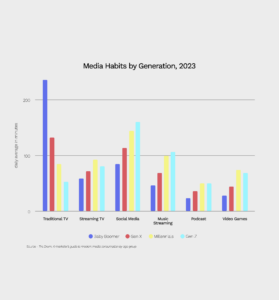In an era where digital transformation dictates where and how we consume content, the political advertising landscape needs a significant shift. Despite projections indicating a surge in political ad spend, with estimates ranging between $10 billion and $12 billion, a significant portion remains anchored in traditional channels. A startling 75% of these budgets, or between $7.5 to $9 billion, are still being spent on traditional broadcast and cable TV ad buys. This strategy persists even as media consumption habits have significantly evolved. At this point, more than 53% of U.S. TV households have cut the cord on cable or never had a cable subscription to begin with, with that number only projected to continue to rise.
The demographic landscape of media consumption underscores the necessity of rethinking how and where to allocate advertising budgets to effectively connect with voters. With the 2024 elections around the corner, we’re helping advertisers navigate this evolving landscape. Over this blog post series, we’ll outline the pertinent shifts in voter behavior toward digital channels, identify better budget allocations to make an impact in 2024 and offer practical tips to remain brand-safe through it all. Up first, let’s dive into those drastic shifts toward digital channels.
The Digital Habits of Voters in 2024

As mentioned, the shift towards digital channels is unmistakable. In 2023, the average U.S. consumer spent 268 minutes with traditional channels compared to 466 minutes with digital channels. While media consumption varies from generation to generation, it is clear that people across the board are allocating significant portions of their day to digital channels like:
- Advanced TV: 83.5 minutes per day across all demographics
- Music streaming: 88 minutes per day across all demographics
- Social media: 139.5 minutes per day across all demographics
As these channels become a larger part of daily media consumption, they present a unique opportunity for engaging with voters across various demographics. Here’s a closer look at where voters are spending their time online.
Advanced TV: A New Leader in Screen Time
In a historic shift, 2024 marks the year advanced TV consumption (2 hours 53 minutes daily) edges past traditional TV viewing (2 hours 48 minutes daily) for the first time. This pivotal change underscores the importance of Advanced TV in the modern voter’s daily routine, highlighting the platform’s dominance in home entertainment and its potential for targeted political messaging.
Mobile: The Digital Gateway
Mobile devices have become the central hub for digital consumption, accounting for over half of all digital media interactions. By 2024, Americans are projected to spend 279 minutes daily on non-voice mobile activities, emphasizing the necessity for mobile-optimized political content to effectively reach and engage voters.
Digital Audio: The Sound of Influence
Digital audio emerges as a significant component of digital media, with individuals dedicating 1 hour 45 minutes to the medium in 2024, making up 20% of all digital consumption. Its impact is particularly pronounced among the 18-35 age group, where 50% report consuming podcasts weekly—nearly matching TV viewership at 54%. This trend points to digital audio’s compelling role in connecting with younger voters, offering a dynamic channel for political discourse.
Social Media: The Cross-Generational Connector
While the landscape of political advertising on social platforms varies. (more on that in our next blog post), their influence in driving digital media adoption is undeniable. Social media usage spans generations, with 58% of those 65+ using Facebook, 67% of those 50-64, 65% of those 30-49 engaging with Instagram, and 65% of the 18-29 demographic active on Snapchat. TikTok, in particular, showcases remarkable growth among younger users, averaging 53.8 minutes of engagement per day, the highest among social apps, followed by X (formerly Twitter) at 34.1 minutes. This widespread adoption across demographics underscores social media’s critical role in shaping political narratives and engaging with the electorate.
Embracing a Digital-First Strategy
As the landscape of political advertising undergoes these significant changes, the urgency for adopting a digital strategy becomes paramount. Understanding and adapting to the digital habits of 2024’s voters ensures that political messages are not just seen but felt in an increasingly crowded digital space.
Discover more insights and strategies for the 2024 elections by downloading our comprehensive guide today. Grab your copy here. Stay tuned for the next part of our series, where we’ll delve deeper into tangible tactics political advertisers can employ across these channels to ensure political messages resonate in the digital age.